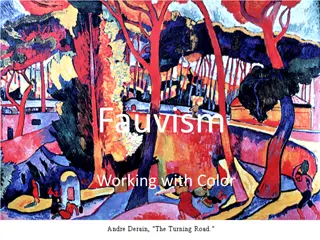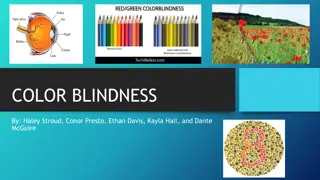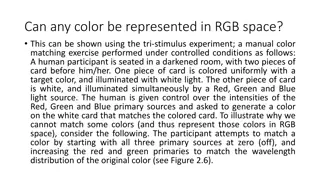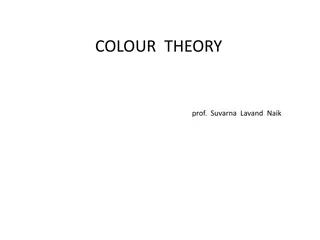Color Models in Multimedia Systems
Color plays a crucial role in multimedia systems, with various models like RGB, CMY, and HSV used for representation. Explore how colors are composed of electromagnetic waves and how different models like RGB and CMY help create a wide range of colors. Understand the significance of hue, saturation, and luminance in color representation for computer monitors. Dive into the RGB color model, grayscale values, and the CMY color model's subtractive approach. Discover the intricacies of color models in the realm of multimedia networking and systems.
Download Presentation

Please find below an Image/Link to download the presentation.
The content on the website is provided AS IS for your information and personal use only. It may not be sold, licensed, or shared on other websites without obtaining consent from the author.If you encounter any issues during the download, it is possible that the publisher has removed the file from their server.
You are allowed to download the files provided on this website for personal or commercial use, subject to the condition that they are used lawfully. All files are the property of their respective owners.
The content on the website is provided AS IS for your information and personal use only. It may not be sold, licensed, or shared on other websites without obtaining consent from the author.
E N D
Presentation Transcript
Department of Computer Science National Tsing Hua University CS 5262: Multimedia Networking and Systems Color Models Instructor: Cheng-Hsin Hsu Acknowledgement: The instructor thanks Prof. Mohamed Hefeeda at Simon Fraser University for sharing his course materials 1
Colors & Color Models Color is composed of electromagnetic waves Humans: visible colors: 370 780 nm Frequency spectrum 2
Colors Pure color has a single wavelength - Could be generated for example by laser Typically, we see a combination of wavelengths - Spectral analysis shows contribution of each wavelength A color could be represented by - Hue: dominant wavelength Wavelength at the spike - Saturation: color purity Area under spike over total area - Luminance: ~brightness Area under curve (power) Hue 3
Color Models The hue, saturation, luminance representation is not well suited for computer monitors - CRT monitors use three phosphors beams Red, Blue, Green (RGB) of varying intensities - LCD: use Red, Blue, Green pixels Common method to create wide range of colors is to combine three primary colors Primary = cannot be generated from each other RGB are good choices because the color receptors in the eyes are specially sensitive to them 4
RGB Color Model Increasing each component with same ratio increases brightness - (0.64, 0.96, 0.78) is brighter shade of green than (0.32, 0.48, 0.39) Grayscale values on the cube s diagonal from (0,0,0) to (1,1,1) - Same value for R,G,B RGB to grayscale conversion: (R, G, B) (L, L, L) - L = 0.30 R + 0.59 G + 0.11 B Eyes are most sensitive to green, and least sensitive to blue 5
CMY Color Model RGB is called additive model CMY (Cyan, Magenta, Yellow) are complements of R,G,B - C = 1 - R; M = 1 G; Y = 1 - B CMY is a subtractive model, i.e., - The origin of the cube is White (not Black), and - (C, M, Y) means how much Red, Green, Blue are subtracted out CMY is used in color printer - Typically with a fourth color: Black (K) To give better clarity and save ink, because (1,1,1) results in muddy brown not true black CMYK 6
HSV and HLS Color Models We mentioned before that a color can be represented by its - Hue (essential color) - Saturation (purity of color) - Luminance (or Value or Lightness) HSV (also called HSB) color model Usually used in computer graphics applications HLS is similar to HSV Non linear transformations from RGB to HSV (or HLS) and vice versa HSV model 7
Luminance & Chrominance Color Models Yet another method to represent color - Put all luminance information in one value (Y) - All color (chrominance) information in other two (IQ) Why? - Allows us to treat components differently Humans more sensitive to Y than IQ - More convenient for television broadcast (in early days) All black & white info in one value (luminance) same transmission for black & white and color TVs YIQ used for TV in North America (NTSC) YUV for TV in Europe (PAL ) YCbCr (similar to YUV): Used in JPEG and MPEG 8
YIQ Model Y: weighted sum of R,G,B Brightness in the image Black & white image Original image Y Component I & Q add the color aspects I Component Q Component 9
Luminance & Chrominance Color Models YIQ RGB using linear transformation Note: Values in matrix depend on the choice of the primaries for RGB 10
CIE XYZ Model and Color Gamut RGB does not capture all visible colors - Some visible colors cannot be produced by adding RGB components ( ) = ( ) + ( ) G b + ( ) C r R g B Color matching experiment - Produce pure colors - Ask observers to vary r, g, b mix till match - Some visible (pure) colors could not be matched unless we added R to them, i.e., subtract R from the mix 11
CIE XYZ Model and Color Gamut This means systems that use RGB model (e.g., monitors) may not able to produce all visible colors Similarly for systems that use CMYK model (e.g., color printers) some colors can be produced on monitors but not on printers and vice versa Color Gamut (or scope): is the range of colors that can be produced (displayed or printed) CIE: Commission Internationale de l Eclairage - Goal: define a model to represent ALL colors - Used to compare color gamut of different color models 12
CIE XYZ Color Model CIE defines three virtual primaries (X, Y, Z) from which all colors can be composed by positive amounts Color given by ( ) = ( ) + ( ) + ( ) C x X y Y z Z X, Y, Z are constants defined by CIE For simplicity, we normalize: ( ) '( ) ( ) ( ) ( ) x y z + + ( ) ( ) ( ) ( ) y x y y z = '( ) = = ; ; '( ) z x y ( ) + + ( ) ( ) + + ( ) x z x z 13
CIE XYZ Color Model '( ) + '( ) + '( ) 1 = Thus, we have: x y z All perceived colors Normalized plane Projection Horseshoe shape 14
CIE Chromaticity Diagram Projection on X,Y CIE Chromaticity Diagram - Represents all visible colors at unit energy On the curved edge, fully saturated (pure, spectral) colors On straight line base, colors that cannot be produced by a single wavelength (nonspectral) A line joining any two colors represents colors that can be created by combining these two colors 15
RGB vs. CMYK on Chromaticity Diagram RGB range is larger, but it does not fully contain CMYK Note: exact gamut depends on the specific constants used for RGB & CMYK 16
RGB CIE XYZ Again depends on the specific constants for RGB 17
Color Models: Summary Different methods for representing colors - Additive (three primary colors: R, G, B) Used in digital cameras, monitors, TVs - Subtractive (three primary colors: C, M, Y Plus K) Good for printers - Luminance & Chrominance: YIQ, YUV, YCbCr Luminance component (Y) and two chrominance components YIQ & YUV used in B&W and color TV (same signal) YCbCr used in JPEG and MPEG compressions - HSV & HSL: Hue, Saturation, Value (or Lightness) Usually used in computer graphics applications - CIE XYZ: Theoretical, comprehensive, used for comparing gamut 18























